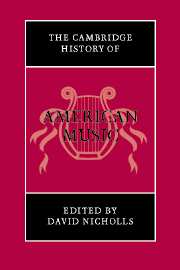Book contents
- Frontmatter
- PART ONE
- 1 American Indian musics, past and present
- 2 Music in America: an overview (part 1)
- 3 Secular music to 1800
- 4 Sacred music to 1800
- 5 African American music to 1900
- 6 Immigrant, folk, and regional musics in the nineteenth century
- 7 Nineteenth-century popular music
- 8 Art music from 1800 to 1860
- 9 Art music from 1860 to 1920
- PART TWO
- Bibliography and references
- Index
- References
8 - Art music from 1800 to 1860
from PART ONE
Published online by Cambridge University Press: 28 March 2008
- Frontmatter
- PART ONE
- 1 American Indian musics, past and present
- 2 Music in America: an overview (part 1)
- 3 Secular music to 1800
- 4 Sacred music to 1800
- 5 African American music to 1900
- 6 Immigrant, folk, and regional musics in the nineteenth century
- 7 Nineteenth-century popular music
- 8 Art music from 1800 to 1860
- 9 Art music from 1860 to 1920
- PART TWO
- Bibliography and references
- Index
- References
Summary
In 1780, John Adams wrote home from Paris to his wife Abigail:
I could fill volumes with descriptions of temples and palaces, paintings, sculpture, tapestry, porcelain, etc., if I could have the time, but I could not do this without neglecting my duty. My duty is to study the science of government that my sons may have the liberty to study mathematics and science. My sons ought to study geography, navigation, commerce, and agriculture in order to give their children a right to study philosophy, painting, poetry, music, architecture, sculpture, tapestry, and porcelain.
(Quoted in Mueller 1951, p. 17)Adams’s prescience - at least concerning music – was remarkably accurate: it was not until the mid-1840s, when his grandson Charles Francis Adams was a young adult, that musical culture in America came of age. Music, of course, had been an important part of American life during the Colonial and early Federal periods. But the 1840s marked the United States’s emergence as a true music-supporting nation, equipped with the infrastructure necessary for the performing arts. With that development, musical culture could only grow, as it did throughout the 1850s.
Because the American musical environment changed so significantly after the mid-1840s, this chapter is divided into two parts. The first half introduces the situation at the dawn of the century and explores the foundation-building endeavors of the 1810s through the mid-1840s; the second covers the context and circumstances of musical activity in the mid-1840s and 1850s.
- Type
- Chapter
- Information
- The Cambridge History of American Music , pp. 186 - 213Publisher: Cambridge University PressPrint publication year: 1998
References
- 3
- Cited by

